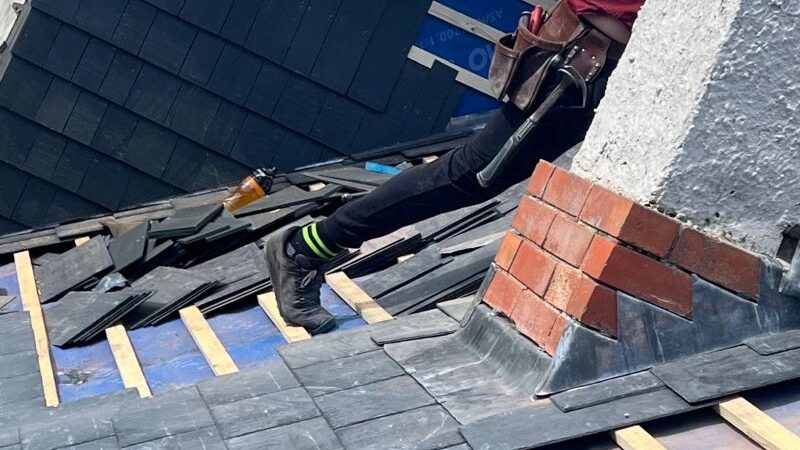Enhance the Durability of Your Slate Roof with High-Quality Flashing to Avoid Expensive Water Damage
Flashing serves as an essential protective barrier at the most susceptible areas of your roof, particularly where tiles intersect with walls, chimneys, or valleys. Inadequate flashing installation can lead to leaks, even in the most expertly fitted slate roof, resulting in costly repairs over time. The use of lead for flashing in slate roofing is preferred due to its exceptional flexibility, remarkable durability, and design that accommodates the natural movements of the roof structure, ensuring a secure seal that effectively prevents water ingress.

Understanding the Importance of Flashing for Your Slate Roof’s Integrity
Flashing is a critical material utilised to seal joints and edges around structures such as chimneys, skylights, roof valleys, and any intersection where your slate roof meets a wall or changes direction. These joints are especially vulnerable to water infiltration, and without effective flashing, they are often the first points of failure, leading to leaks. In contemporary construction, flashing may be fabricated from sheet metals, but for traditional applications on slate roofs, lead remains the superior choice.
Why opt for lead? This material not only creates a robust seal but also moulds itself to form a strong barrier against various curves, slopes, and edges. It naturally expands and contracts with temperature fluctuations without the danger of cracking or splitting. Unlike synthetic alternatives, lead is resistant to rust and maintains its structural integrity for a significantly longer period, often outlasting the slate tiles it protects.
Understanding the Consequences of Poorly Installed or Failing Flashing
Even the smallest tear or gap in your flashing can lead to substantial leaks. These leaks are rarely straightforward; moisture can penetrate beneath the tiles, reach the underlay, and gradually create issues such as rot, mould, or damage to your internal ceilings. The consequences of flashing failure may not be immediately apparent, often taking years to surface, and by then, the necessary repairs can become extensive and financially burdensome. Issues related to flashing are among the leading causes of hidden roof failures.
If you notice stains on your ceiling, bubbling paint near a chimney, or patches of moss accumulating in specific areas on your roof, deteriorating flashing may be the underlying issue.
Why Lead Flashing Remains the Best Choice for Slate Roofs
For centuries, lead has been the preferred material for slate roofs due to its unique characteristics. It is recyclable, exceptionally durable, and can withstand severe weather conditions, whether during intense heat or storms. The malleability of lead allows it to fit snugly without risking damage to the delicate slate, which is comparatively fragile in nature.
Common applications of lead flashing include:
- Chimney flashings (both step and apron)
- Roof valleys
- Secret gutters
- Roof-to-wall junctions
- Ridge and hip intersections
- Skylight surrounds
These areas experience movement, pressure, and water runoff, making them particularly susceptible to failure when using hard, inflexible materials that can crack or displace.
Identifying When to Replace or Repair Your Lead Flashing
While lead flashing typically boasts longevity, it will eventually show signs of wear and tear. You should consider replacement if:
- The lead has developed splits or cracks
- It is lifting or curling away from the roofline
- Rust is visible, especially where lead meets other metals
- Water stains are visible inside your home
- You are already planning a slate roof repair or rebuild
Most slate roof restorations include a thorough inspection of all leadwork. If our team is already on your roof for tile replacement or cleaning, now is the perfect opportunity to assess and replace flashing as required.
The Importance of Engaging Skilled Craftspeople for Leadwork
Leadwork is a specialised trade that should not be entrusted to just any general roofer or handyman. Poorly installed lead can sag, split, or detach from the slate, undermining the advantages of a well-constructed slate roof. Our team employs traditional methods for installing lead flashing, ensuring proper sizing, correct lap joints, and expansion joints that accommodate the weather fluctuations typical in Sydney. We pledge to use lead only where it is the most appropriate material for the task.
How Quality Flashing Can Reduce Future Roofing Problems
A slate roof can endure for a century or more, but only if its most vulnerable points are adequately protected. Flashing and leadwork may not be the most glamorous components of a roof, yet they are crucial elements that bear the burden when harsh weather conditions arise. If you observe leaks, streaks, or signs of wear around your chimney or roof edges, it is imperative to have these checked promptly. Replacing flashing now can save you from incurring significantly higher repair costs for structural damage later.
Are You Seeking a Professional Inspection for Your Leadwork?
If your slate roof features flashing that has seen better days or is exhibiting signs of wear, it is prudent to have it assessed before minor issues escalate into major damage. Contact us today to schedule an inspection with a team that comprehensively understands slate, lead, and the intricate details that effectively hold your roof together.
Your Questions Answered: Flashing and Leadwork Explained
What Is Flashing on a Slate Roof and Why Is It So Important?
Flashing is the material used to seal joints and transitions in the roofing system—such as around chimneys, valleys, and skylights—preventing moisture from penetrating the roofing structure.
Why Is Lead the Preferred Material for Slate Roof Flashing?
Lead is highly flexible, durable, and resistant to adverse weather conditions. It adapts seamlessly to the contours of slate tiles and outlasts synthetic alternatives, making it the ideal choice for flashing.
What Is the Expected Lifespan of Lead Flashing?
With proper installation, lead flashing can last for 50 years or more, often outlasting the slate roof it is designed to protect.
Can Flashing Be Repaired Without Replacing the Entire Roof?
Indeed, damaged or worn flashing can be repaired or replaced without the necessity of undertaking a full slate roof replacement, provided that the issues are promptly addressed.
What Are the Signs of Flashing Failure?
Indicators of flashing issues include water stains near chimneys, damage to ceilings, moss growth in isolated areas, or visible gaps where roof surfaces converge.
Do All Slate Roofs Require Lead Flashing?
Most slate roofs indeed require flashing. Areas such as chimneys, valleys, and wall junctions necessitate flashing, with lead being the material of choice due to its compatibility with slate.
Is It Safe to Use Lead Flashing in Residential Homes?
Yes, when installed by professionals, lead flashing poses no safety concerns. It remains the most effective and traditional choice for slate roofs.
The Article: Leadwork and Flashing: Why It’s Crucial for a Slate Roof first appeared on https://writebuff.com
The Article Leadwork and Flashing: The Importance for Slate Roofs Was Found On https://limitsofstrategy.com
